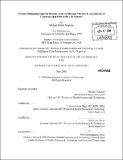| dc.contributor.advisor | T. (Teo) Forcht Dagi and Carl Berke. | en_US |
| dc.contributor.author | Magnani, Michael Robert | en_US |
| dc.contributor.other | Harvard University--MIT Division of Health Sciences and Technology. | en_US |
| dc.date.accessioned | 2010-04-28T15:35:41Z | |
| dc.date.available | 2010-04-28T15:35:41Z | |
| dc.date.copyright | 2009 | en_US |
| dc.date.issued | 2009 | en_US |
| dc.identifier.uri | http://hdl.handle.net/1721.1/54459 | |
| dc.description | Thesis (S.M.)--Harvard-MIT Division of Health Sciences and Technology, 2009. | en_US |
| dc.description | Cataloged from PDF version of thesis. | en_US |
| dc.description | Includes bibliographical references (p. 68-69). | en_US |
| dc.description.abstract | Corporate spin-outs have become more frequent in the contemporary business environment as an alternate source of risk diversification and value creation for both the parent and external investors. Once established, corporate spin-outs are often perceived to be of higher quality than their counterparts in the industry; previous studies have shown that they tend to receive higher valuations in financing, faster financing and higher preference by prestigious Wall Street investment banks when they decide to go public. The primary objective of this thesis was to compare the net proceeds associated with successful liquidity events (IPO or M&A) for US based therapeutic-focused corporate spin-outs to industry averages and test the hypothesis that corporate spin-outs generate superior returns. A database containing information on 186 corporate spin-outs within the life sciences (founded from 1990 - present) was generated for the purpose of testing this hypothesis. Net proceeds from corporate spin-out liquidity events were compared to median net proceeds of all biotech/pharmaceutical liquidity events for a given vintage year and type of liquidity event (IPO vs. M&A). Liquidity events were observed with a | en_US |
| dc.description.abstract | (cont.) higher frequency than overall industry averages. Results indicated that net IPO proceeds were similar to industry averages, while M&A proceeds were above the median vintage year value for every case observed. When normalizing by the most advanced clinical stage program, a similar trend was observed in three of the five cases. In addition, internal rate of return (IRR) and cash on cash exit multiple for Series A investors was substantially higher in corporate spin-outs than industry averages. In order to understand why acquisitions of corporate spin-outs appeared to generate sizable excess returns relative to industry averages, qualitative interviews were conducted with former executives involved in these transactions. Key insights from these interviews indicate that a seasoned management team, prestige of parent company, high quality syndicate of investors, clinically proven technology and a clear regulatory path to approval are all elements that help drive excess valuations of corporate spin-outs in the life sciences. We conclude that corporate spin-outs do generate superior returns through M&A exits compared to venture-backed start ups, while proceeds from IPO's were similar to case controls. | en_US |
| dc.description.statementofresponsibility | by Michael Robert Magnani. | en_US |
| dc.format.extent | 85 p. | en_US |
| dc.language.iso | eng | en_US |
| dc.publisher | Massachusetts Institute of Technology | en_US |
| dc.rights | M.I.T. theses are protected by
copyright. They may be viewed from this source for any purpose, but
reproduction or distribution in any format is prohibited without written
permission. See provided URL for inquiries about permission. | en_US |
| dc.rights.uri | http://dspace.mit.edu/handle/1721.1/7582 | en_US |
| dc.subject | Harvard University--MIT Division of Health Sciences and Technology. | en_US |
| dc.title | Factors influencing superior returns achieved through mergers & acquisitions of corporate spin-outs in the life sciences | en_US |
| dc.type | Thesis | en_US |
| dc.description.degree | S.M. | en_US |
| dc.contributor.department | Harvard University--MIT Division of Health Sciences and Technology | |
| dc.identifier.oclc | 551181468 | en_US |
